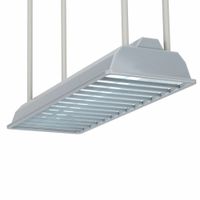Bay lights contribute to energy efficiency in large spaces through several mechanisms. Firstly, they utilize advanced LED technology, which consumes significantly less power compared to traditional lighting options like incandescent or fluorescent bulbs. LEDs convert a higher percentage of electricity into light, reducing energy waste.
Secondly, bay lights offer high luminous efficacy, meaning they provide more light per watt of electricity consumed. This allows fewer fixtures to be used to achieve the same level of illumination, further cutting down on energy usage.
Thirdly, bay lights often come with dimming capabilities and smart controls, allowing for adjustments based on occupancy or natural light availability. This adaptability ensures that lights are only used when necessary and at optimal levels, preventing unnecessary energy consumption.
Additionally, bay lights have a longer lifespan, reducing the frequency of replacements and the associated energy costs of manufacturing and transporting new bulbs. Their durability also means less maintenance, which can be energy-intensive.
Moreover, bay lights distribute light more evenly, reducing the need for additional fixtures to eliminate dark spots. This efficient distribution minimizes the total number of lights required, directly impacting energy savings.
Finally, bay lights can be integrated with energy management systems that optimize lighting schedules and monitor energy usage, providing data to further enhance efficiency strategies. These systems can automatically adjust lighting based on real-time data, ensuring that energy is used judiciously.
In summary, bay lights enhance energy efficiency in large spaces by utilizing LED technology, offering high luminous efficacy, incorporating smart controls, having a long lifespan, providing even light distribution, and integrating with energy management systems.
